Aphids are soft-bodied insects that coat the leaves and stems of your plants and suck the sap from your garden plants. They range in different colors, from green to gray or reddish brown. Fortunately, these are easy to find and easy to get rid of. Aphids are a group of insects belonging to the Aphididae family.
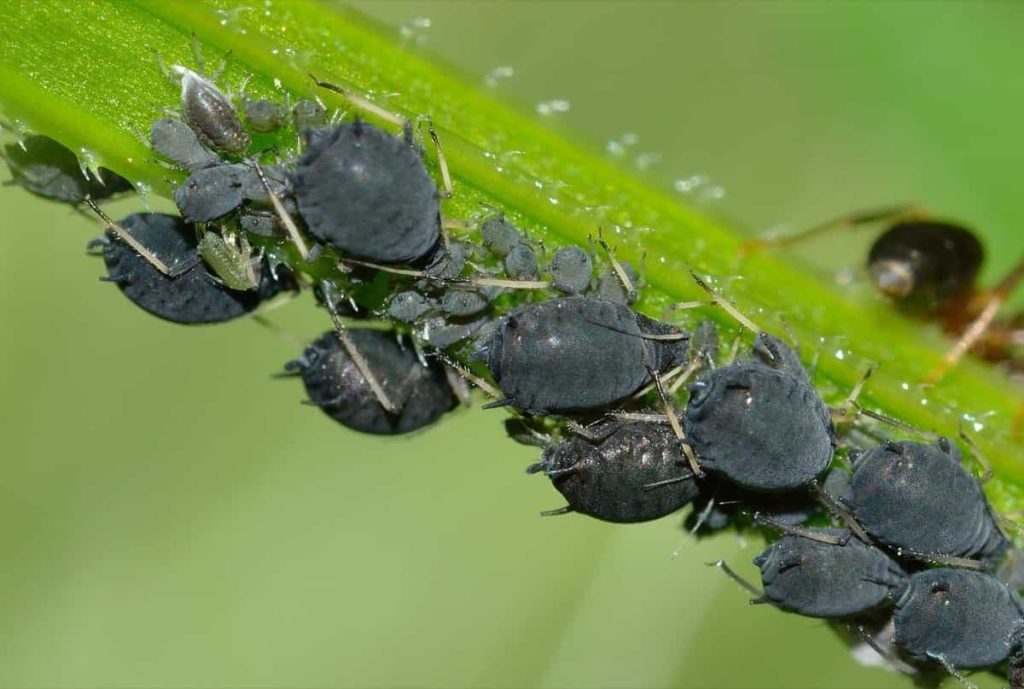
There are several thousand species of small insects in this large family, and they all have boring mouthparts that allow them to feed on plant sap. Aphids feed on various plants, but some species may be specific to certain plants. For example, some aphid varieties are bean aphids, cabbage aphids, potato aphids, green peach aphids, and melon aphids. Let’s check out how to control Aphids on plants naturally and organically.
Aphid damage symptoms in plants
- Aphids are among the most destructive pests of cultivated plants in temperate regions. They are a source of fear for many growers, as they can cause yellow, droopy leaves, stunted growth, dense foliage, browning, low yields, and even plant death.
- Aphids pierce plant stems – preferring succulent new growth – sucking the nutrient-rich sap, weakening the plant and causing it to die. In addition, aphids carry deadly viruses that infect the host plant as they feed. These viruses can easily damage potatoes, citrus fruits, and cereals.
- Additionally, the honeydew secreted by aphids creates an environment for leafhoppers that spreads through the skin and envelopes the plant’s leaves, depriving them of sunlight. Look for symptoms such as curling, stunting, or yellow leaves to detect aphid infestation.
- Check the underside of leaves, as aphids like to hide. If a sticky substance appears on the stems or leaves, this can be an indication that aphids are infesting the plant. Honeydew can develop a fungus called sooty mold, which causes branches and leaves to appear black.
- Flowers or fruits may be deformed due to feeding on aphids. Some aphid species cause galls to infect or leave the roots.
- Look for misshapen, curling, stunted, or yellow plant leaves. Aphids like to hide there.
- If the plant leaves are covered with a sticky substance, this is a sign that aphids are sucking sap. This “honeydew,” a sugary liquid produced as waste by insects, can attract other insects, such as ants, which collect the food material. When aphids feed on trees, their honeydew can fall onto cars, outdoor furniture, driveways, etc.
- Honeybees sometimes encourage the growth of a fungus called sooty mold, which causes branches and leaves to appear black.
- Flowers or fruits may be distorted or deformed due to feeding on aphids. Some aphid species cause leaf spotting on roots or leaves.
- Aphids can transmit viruses between plants and attract other insects that prey on them, such as ladybugs.
Identification of aphids in plants
Aphids are small, which means adults are less than 1/4 inch and are often almost invisible to the naked eye. Different species can appear white, black, brown, gray, yellow, light green, or even pink. Some may have a wax or wool coating. Their bodies are pear-shaped with long antennae. Nymphs (young aphids) look similar to adults. Most species have two small tubes (called cornicles) extending from their hind end.
How to control Aphids on plants naturally and organically
Try one of these safe and easy home remedies to kill aphids in your garden, prevent the return of aphids, and control ants.
Spray with soapy water
Add a few drops of dish soap to a spray bottle, top up using water and then shake to dissolve. Spray the solution over the plant, being sure to reach all parts of the plant, including the undersides of the leaves. Soapy water traps and suffocates aphids. Make a homemade aphid spray by mixing a few tablespoons of pure liquid soap in a small bucket of water. (Avoid using soaps or products with degreasers or moisturizers).
Apply from a spray bottle directly to aphids and affected parts of the plant, making sure to soak the undersides of leaves where larvae and eggs like to hide. Soap dissolves the outer layer of aphids and soft-bodied insects, eventually killing them. It does not harm beneficial insects like lacewings, ladybugs, or pollinating bees. You can also purchase ready-to-use insecticidal soap online or at a local nursery.
In case you missed it: Okra Pests, Diseases, Symptoms, And Control Measures
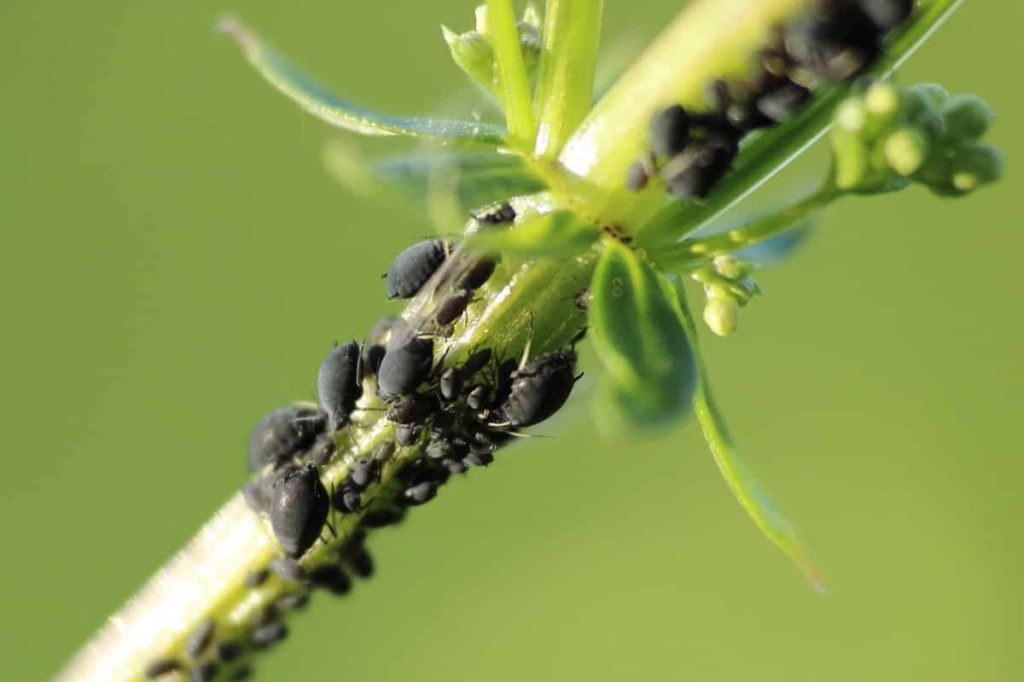
Neem oil
Neem oil is an excellent option for controlling aphids. Neem oil has many good uses, as it discourages the presence of other harmful insects such as cabbage worms, ants, beetles, mealybugs, and caterpillars. It is effective in controlling fungal growth. Neem oil controls various common garden pests like aphids and fungal diseases. It can also be used as an inert spray to control overwintering eggs of different insect pests.
Organic methods
Organic methods include soap emulsions, horticultural oils, and pyrethrum sprays. If using soapy water, reapply every 2 to 3 days for two weeks. You can control aphids through the use of natural repellents. However, it is important to avoid harsh chemicals, as they can negatively affect your plants and garden ecosystem. Instead, the leaves of Onion, Garlic, and Tomato plants are a natural aphid deterrent that won’t harm your garden. These are best applied by using a spray applied to the plant leaves.
Grow aphid repellent plants
Plant flowers like Marigolds, Nasturtiums, and Sunflowers in your garden to get rid of pests naturally. Plant herbs such as Catmint, Lavender, Turmeric, Ginger, and Oregano to repel aphids. Vegetables that aphids do not like are Onions and Garlic. Another way to control aphids is to grow plants that repel them between vegetable patches, garden beds, and rows of ornamentals that aphids particularly like, such as Eggplant.
Use liquid dish soap
Mix 2 to 4 teaspoons of liquid soap in a gallon of water and fill the solution into a spray bottle. Apply it to the affected plant, especially under the foliage.
Use essential oils
Another organic way to get rid of aphids is with essential oils. While they may not kill aphids, they will keep them at bay. Peppermint and lavender oils are suitable for this purpose. You can also mix them into your spray recipes.
Plant nectar-producing flowers
Alyssum, Cilantro, Hyssop, and other beneficial insects near aphid-susceptible plants will attract insects like ladybugs, hoverflies, lacewings, and parasitic wasps that prey on soft-bodied insects. Yellow jackets are also excellent aphid eaters.
Steps to make garlic spray for controlling Aphids
- Peel a bulb of Garlic and put it in a blender. Add a cup of water and puree for about a minute until finely chopped. If you don’t have a blender, a food processor or immersion blender will do, or you can use a garlic press to chop or mince the Garlic and then blend it with water.
- Pour the garlic mixture into a bowl and add about 3 cups water and two tablespoons of liquid soap. Cover it and let it sleep overnight. Liquid dish soap coats the larvae and suffocates them.
- Strain and pour into a spray bottle. The tension ensures that the garlic nozzle is not blocked.
- You can add a teaspoon of ground cayenne or hot pepper when the Garlic is helpful to make your spray stronger. Adding black pepper makes the garlic spray capable of repelling various pests.
Tips to prevent aphids
Spray dormant horticultural oil to kill overwintering aphid eggs for fruit or shade trees. Beneficial insects like ladybugs, lacewings, and parasitic wasps, will feed on aphids. Attract these insects to your garden by providing an environment that has lots of flowers, as well as access to water. Supplemental populations of insects can be ordered online and help keep the aphid population under control right from the start.
Companion planting helps keep aphids away from plants or help keep them away from plants you want to grow. For example:
- Aphids are repelled by catnip.
- Aphids are attracted to Mustard and Nasturtium. Plant them near more valuable plants to trap aphids.
- Nasturtiums make spoiled fruit trees taste sap for aphids and will help keep aphids away from Broccoli.
- Chives and Garlic repel aphids when planted near plants like Lettuce, Peas, and Rose Bushes.
- Prevent aphids on fruit or shade trees; spray with dormant oil to kill overwintering eggs.
- Invite insects that feed on aphids such as lady beetles, lacewings, and parasitic wasps.
- Plant floral ground covers to attract predators.
- Companion planting is beneficial in keeping aphids at bay. Apply catnip to keep aphids away from Broccoli Nasturtium plants.
Control Aphids in Vegetables
Aphids on vegetable plants are yellow, green, red, or brown and pear-shaped. They usually reproduce in colonies that gather on the underside of leaves. A bad infection results in stunted, wilted plants and weak plants. They are often hidden in organic leafy greens such as Collards, Kale, Lettuce, Mustard, and Spinach so these greens should be washed thoroughly before serving.
In case you missed it: Ginger Diseases, Pests, Symptoms, And Control
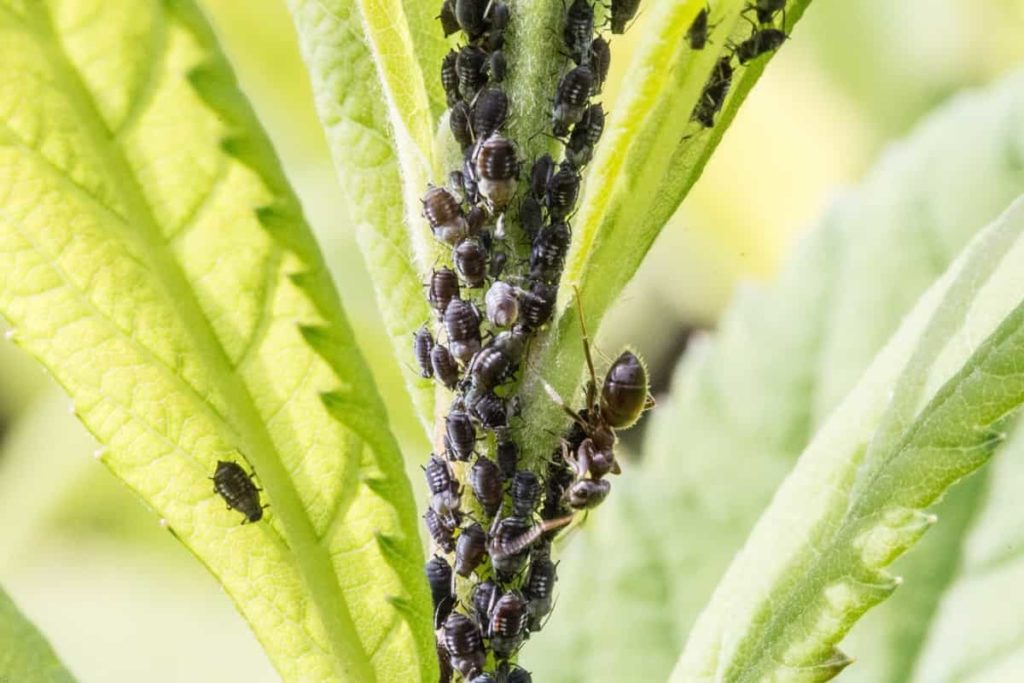
Eating aphids will never cause disease. They cannot make anyone sick, either through ingestion or skin contact. Diseases spread by aphids are purely planted diseases; thus, no disease or harm will come to anyone who ingests or touches the aphids.
Affected plants: Aphids feed on many species of potential host vegetable plants, including Tomatoes, Lettuce, Bananas, and Cabbage. Their wonderful nature makes them sure to be on every vegetable garden pest guide.
Damage: Aphids suck plant sap, causing stunted, stunted growth.
Get rid of aphids on vegetables
- Eliminate the problem – Fill a bucket with warm, soapy water. Cut off the aphid-infested leaves and immerse them in soapy water to kill the insects. This method works best when plants have a mild aphid infestation.
- Feed your plants – Instead of synthetic nitrogen fertilizers on your vegetable plants, apply a time-released urea-based fertilizer. Using too much nitrogen on plants at once can increase aphid populations.
- Continue checking the plants – Spray the affected plants with a strong spray of water and rinse the aphids from the plants. Repeat daily until the worms are gone. Aphids rarely find their way back into plants after you knock them off.
- Treat affected plants – Treat badly infested plants with insecticidal soap or neem oil spray, following package directions. Apply them directly to the affected parts of the plant, coating the aphids. Repeat the application every 2 to 3 days until the aphid population is reduced. Mix equal parts about 70 percent alcohol and water for an effective spray. Or, combine 5 cups of water, 2 cups of rubbing alcohol, and one tablespoon of mild liquid soap for a spray.
- Promote beneficial predatory insects by including many flowering plants with small flowers in the garden.
- Physical control – You can remove aphids from plants by spraying them with a strong stream of water from a hose. Aphids easily squeeze out by hand or cover the plants with floating mulch to protect them from pests.
- Organic product control – Use horticultural oil, insecticidal soap, or neem-based insecticides to eliminate challenging aphid infestations.
Control Aphids in Herbs
Aphid damage can be identified quickly and effectively. It would help if you looked for the following:
- Houseplant leaves that are misshapen, curled, or yellow
- A sticky substance on the stem of a houseplant
- Herbs that are growing deformed
- Leaves on roots or leaves
- Small insects on the opposite side of the leaf
- Large numbers of small insects on the stem of the plant
- Small insects on the root of the plant
In case you missed it: Ginger Diseases, Pests, Symptoms, And Control
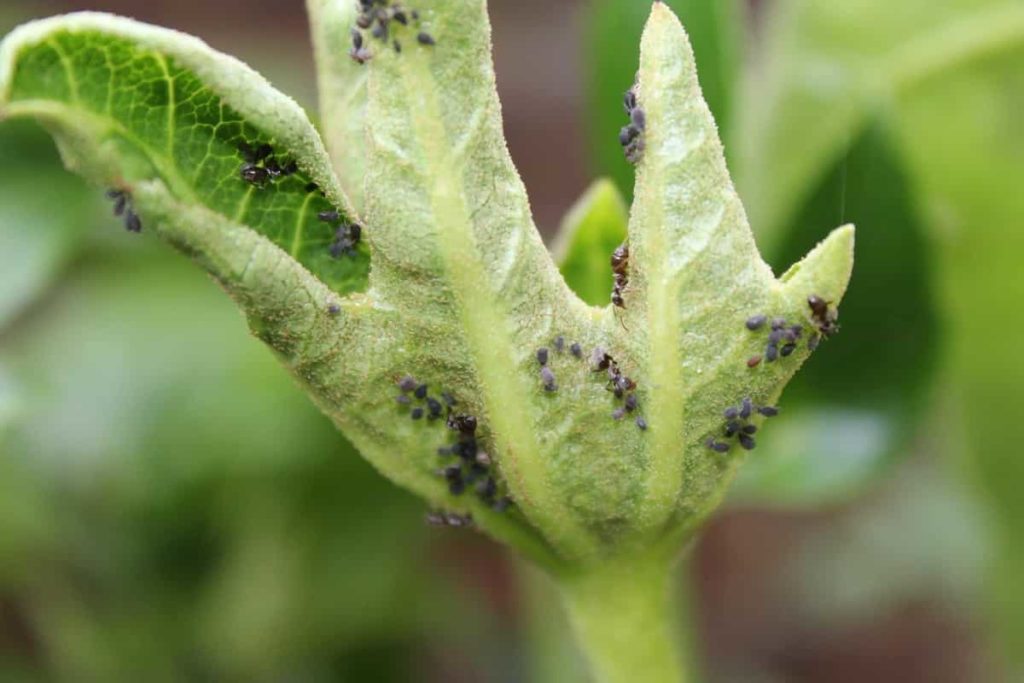
What Herbs Get Rid of Aphids?
Plant some herbs that help repel aphids. Plant repel aphids include Chives, Coriander, Dill, Garlic, Mint, and Nasturtium. Plant these herbs in a protective row at the edge of the garden or near herbs more prone to aphids. Plant some herbs that help repel aphids.
Avoid excessive nitrogen fertilization, which stimulates the growth of soft, new plant tissue that aphids love to eat.
Maintain or increase populations of natural aphid predators and parasites such as lady beetles, lacewings, syrphid bees, and parasitic wasps. Avoid using broad-spectrum insecticides, which often have a more damaging, long-lasting impact on predator populations than on aphids. Planting a diverse range of scented herbs or flowers helps attract beneficial insects.
Remove aphids from plants with a strong water spray from a garden hose. Many aphids are wingless, and those with wings are poor fliers. Repeating this spray every several days can provide adequate control.
Spray the herb plants with neem oil, horticultural oil, or insecticidal soap. Cover the top and bottom of the plant leaves with spray to ensure complete control. Soaps and oils have no lasting effect, only killing aphids and other pests on the herb when applied, so repeat applications every 7 to 10 days are often necessary to achieve control.
Control Aphids in Fruits
They are common pests affecting a variety of fruit trees. They affect plants but can also infect Peaches, Nectarines, Cherries, and even Apples and Pears. Start checking fruit trees in the spring as soon as they produce buds. Aphids often congregate on the undersides of plant leaves and nitrogen-rich new plant growth.
An easy, non-toxic way to get rid of aphids on fruit trees is to spray them under the leaves with water pressure. Avoid wetting the plant leaves during the hottest part of the day, warns Philly Gardens. Many beneficial insects prey on aphids, including ladybugs and lacewing larvae. These insects are available for purchase, although they can appear independently, mainly if you plant flowers that attract them. Ants protect aphids and prevent predators from reaching them.
Tips for getting rid of aphids in fruits
- Monitor your trees regularly for aphids.
- If you identify that you have aphids, look very carefully to see if there are any predatory insects around that are eating them. Spiders, ladybirds, and wasps are all particularly prolific aphid eaters.
- Check if ants are associated with aphids in your tree.
- Prevent the aphids from reaching the aphids by placing a sticky barrier between the aphids and the ant nest.
- Focus on building plant biodiversity under your fruit trees. For example, flowering plants, especially white and yellow flowers, are great at attracting and providing habitat for predatory insects.
- Unhealthy trees attract more aphids, so focus on improving your tree’s health and soil growth.
In case you missed it: Crop Pest and Disease Management – a Full Guide
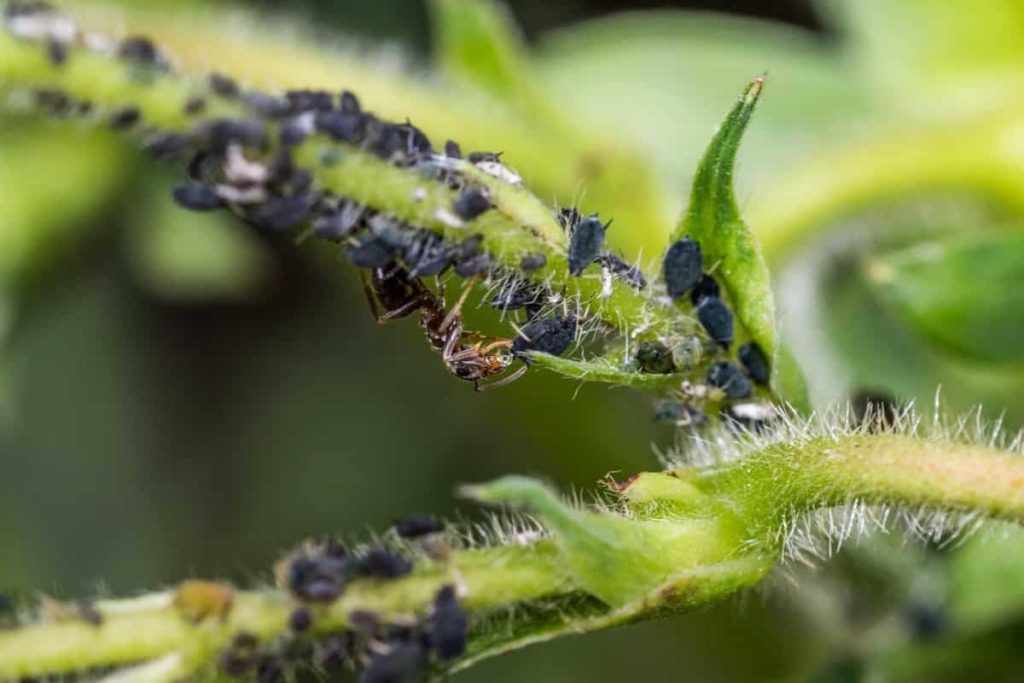
Frequently asked questions about Aphids in plants
What is the best killer for aphids?
If an insecticide is required, insecticidal soaps and oils are the best choices for most situations. Oils can include petroleum-based horticultural oils such as neem or canola oil. These products primarily kill aphids by killing them, so complete coverage of infested plants is required.
What causes an aphid infection?
Aphids become a problem when things go wrong, usually when plants are experiencing drought, poor soil conditions, or overcrowding.
Why do aphids come back?
The main reasons aphids return are their constant reproduction, hiding ability, and ability to move to new plants. Pest control, especially aphids, is not a one-time deal.
Do aphids live in soil?
Unlike their root aphid cousins, aphids do not live in or under the soil. Therefore, they cannot survive in such an environment because they need to feed on plant micronutrients to survive and reproduce.
Will aphids spread to other plants?
Aphids often spread to other plants in late summer and fall as they seek new food sources. Some aphids seek out specific plants. Other species—such as green peach aphids (Myzus persicae) and cotton/melon aphids (Aphis gossypii)—can infect many plants.
Does vinegar get rid of aphids?
Vinegar is effective at killing aphids and ants and is also better for the environment. This home solution can fight aphid pests while maintaining a healthy garden for beneficial insects like bees and ladybugs.
Do banana peels keep aphids away?
Avoid using potentially dangerous pesticides to repel aphids and ants from the garden by using orange and banana peels to repel insects. Cut banana peels and bury them 1 to 2 inches deep in the soil around plants prone to aphid infestations to remove aphids from the area.
How long will aphids last?
The lifespan of an aphid is approximately 1 month. It reaches maturity in 4 to 10 days and can produce its offspring.
In case you missed it: Beans Diseases, Pests, and Control Methods
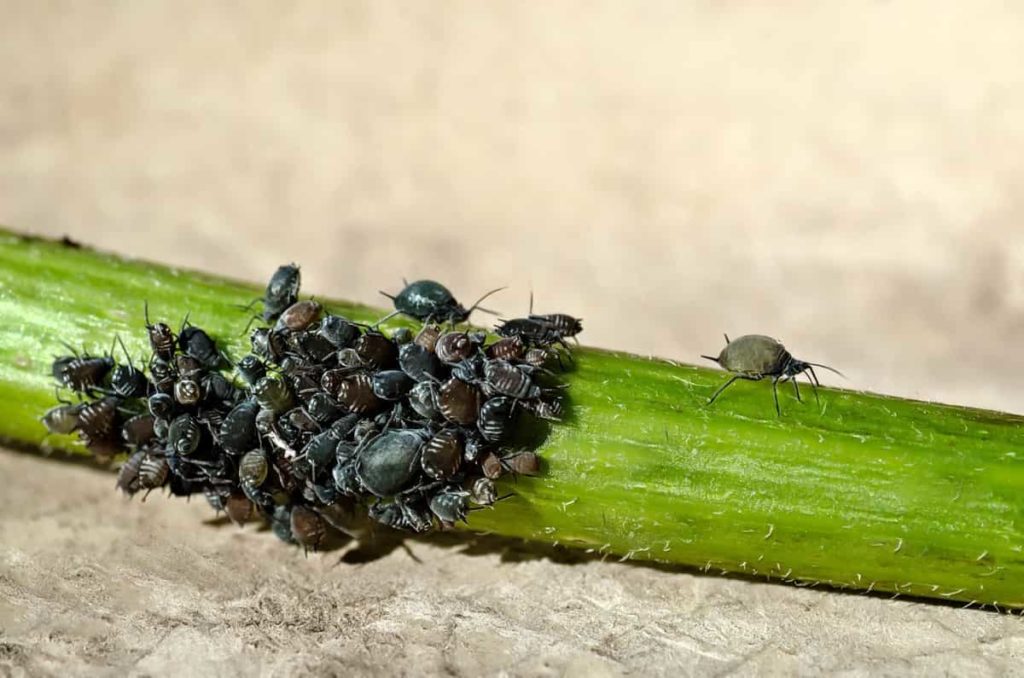
Do aphids harm plants?
Aphids can stunt growth and weaken plants with twisted or distorted leaves. Many aphids secrete a sticky honeydew on which black molds can grow. White scales of aphids may accumulate on the upper surface of the leaves.
Conclusion
Aphids quickly enter indoor and outdoor gardens. Small, soft-bodied insects grow quickly, so you need to control them before they reproduce. Aphids are among the breeding pests of cultivated plants. These destructive insects cause significant damage to agricultural plants, especially in temperate regions. The above steps are different ways to get rid of aphids.
- How to Make Houseplants Bushy: Effective Tips and Ideas
- Innovative Strategies for Boosting Coconut Pollination and Yield
- Pollination Strategies for Maximum Pumpkin Yield
- The Complete Guide to Chicken Fattening: Strategies for Maximum Growth
- Natural Solutions for Tulip Problems: 100% Effective Remedies for Leaf and Bulb-Related Issues
- Revolutionizing Citrus Preservation: Towards a Healthier, Greener Future
- Natural Solutions for Peony Leaf and Flower Problems: 100% Effective Remedies
- Maximizing Profits with Avocado Contract Farming in India: A Comprehensive Guide
- Natural Solutions for Hydrangea Problems: 100% Effective Remedies for Leaf and Flowers
- The Ultimate Guide to Choosing the Perfect Foliage Friend: Bringing Life Indoors
- From Sunlight to Sustainability: 15 Ways to Use Solar Technology in Agriculture
- The Ultimate Guide to Dong Tao Chicken: Exploring from History to Raising
- The Eco-Friendly Makeover: How to Convert Your Unused Swimming Pool into a Fish Pond
- Mastering the Art of Delaware Chicken Farming: Essentials for Healthy Backyard Flocks
- 20 Best Homemade Fertilizers for Money Plant: DIY Recipes and Application Methods
- How to Craft a Comprehensive Free-Range Chicken Farming Business Plan
- Brighten Your Flock: Raising Easter Egger Chickens for Beauty and Bounty
- How to Optimize Your Poultry Egg Farm Business Plan with These Strategies
- Subsidy for Spirulina Cultivation: How Indian Government Schemes Encouraging Spirulina Farmers
- Ultimate Guide to Raising Dominique Chickens: Breeding, Feeding, Egg-Production, and Care
- Mastering the Art of Raising Jersey Giant Chickens: Care, Feeding, and More
- Ultimate Guide to Raising Legbar Chickens: Breeding, Farming Practices, Diet, Egg-Production
- How to Raise Welsummer Chickens: A Comprehensive Guide for Beginners
- How to Protect Indoor Plants in Winter: A Comprehensive Guide
- Ultimate Guide to Grow Bag Gardening: Tips, Tricks, and Planting Ideas for Urban Gardeners
- Guide to Lotus Cultivation: How to Propagate, Plant, Grow, Care, Cost, and Profit
- Agriculture Drone Subsidy Scheme: Government Kisan Subsidy, License, and How to Apply Online
- Ultimate Guide to Raising Araucana Chickens: Breed Profile, Farming Economics, Diet, and Care
- Bringing Hydroponics to Classroom: Importance, Benefits of Learning for School Students
- Ultimate Guide to Raising Polish Chickens: Breed Profile, Farming Economics, Diet, and Care
- Ultimate Guide to Raising Australorp Chickens: Profile, Farming Economics, Egg Production, Diet, and Care
- Silkie Chicken Farming: Raising Practices, Varieties, Egg Production, Diet, and Care
- Sussex Chicken Farming: Raising Practices, Varieties, Egg Production, Diet and Care
- Homemade Feed Formulations for Livestock: Discover Cost-effective Starter to Finisher Feed Recipes
- 20 Best Pig Weight Gain Supplements: Top Swine Weight Gain Formulas
- Ultimate Guide to Elderberry Farming: Propagation, Planting, Yield, Cost, and Profit